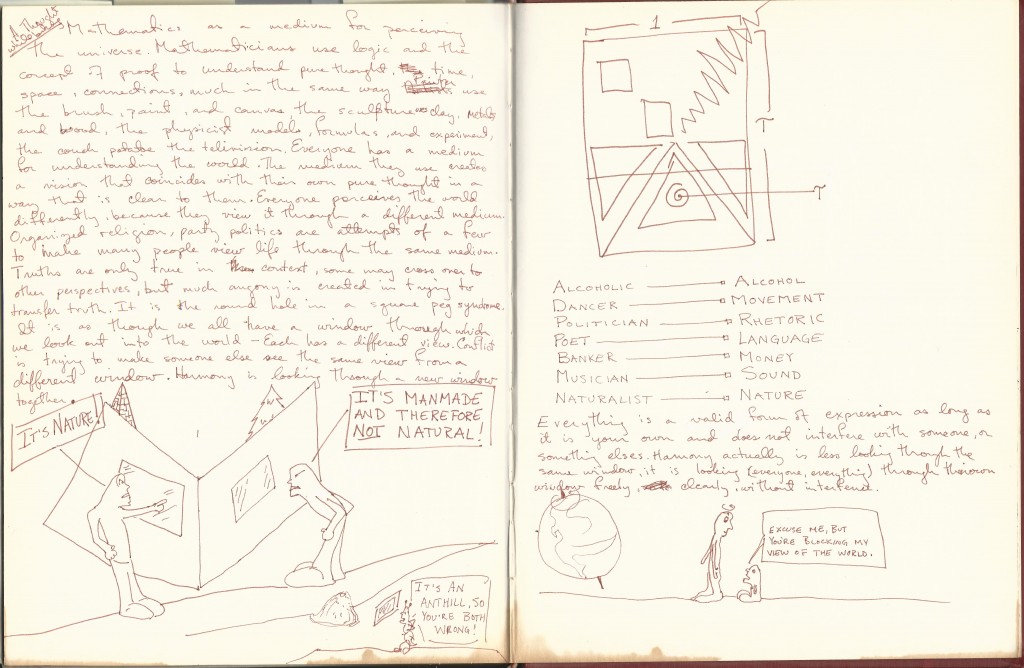Daybook: Happy Ultimate Pi Day!: The Mathematics of Park Design
In honor of one of my favorite numbers, I’m skipping ahead in the daybooks, past my musings on Ginsberg’s poem “Howl” and my cartoon augmented scribing of Ferlinghetti’s “Pictures of the Gone World,” to the next landscape design project, a park between Lake Merritt and the freeway in Oakland. Originally designed by nature as salt marshland (unless you hark way back when the ice age had dropped sea level and this spot of land was probably oak speckled grassland, but you’d have to believe in climate change to do that), the site had experienced a number of changes over time, including conversion into a plop art park by Garrett Eckbo. The morning I walked through the park with Chip Sullivan’s design class, I didn’t know Garrett Eckbo was an uber famous landscape architect whom I would someday teach about in a landscape history course in Arizona.
That’s the thing about time. Even if you know it’s passing, you can never tell where it’s going. The future me was going to be a college professor in the desert. The present me wore leg-warmers that morning, because the air was full of cold fog and it was 1988 (who didn’t love Jennifer Beals in Flash Dance?). And the past me?
Before starting design school, I taught high school math. I spent my days waxing on about the wonders of numbers like Pi to a classroom full of fascinated teens. They were fascinated in one another, but at least they were excited. Anyhow, Pi’s irrationality is one of its charms. Another is its connection to circles. As a high school calculus student, I had written a treatise on circles (pretty sure this is a math nerd indicator). As a teen, I was fascinated by other teens, mostly my dreamy boyfriend who turned out to be a jerk, but I had some room in my thrill chamber (a math nerd means her head when using this term) for mathematical things that looked finite, but weren’t, like circles, line segments, and irrational numbers. My favorite lines of poetry as a teen were from William Blake’s “The Augeries of Innocence”:
To see a World in a Grain of Sand
And a Heaven in a Wild Flower,
Hold Infinity in the palm of your hand
And Eternity in an hour.
Time and space have this same bounded yet expansive quality. If you walk into a park you’ve never been to, you carry in your mind and body all the memories of other parks, and these memories color the way you experience this new environment, so you are in the past somewhere else and the present where you stand simultaneously.
For reading, Chip assigned Jorge Luis Borges’s short story “The Garden of the Forking Paths,” which I devoured. At the time, I had no idea it would inform my four book time travel/multiverse novels featuring love and pie. Back then, Borges’s story just made me think of fractals and how time can fold in on itself, like that park experience. So I tried to design a fractal park that pulled up the layered history of the landscape. Easy as pie.
This page was thoughts I had while biking, which is what I used to do when my brain got stuck in studio. I’d hop on my bike and head for the hills. The diagram is a thumbnail of the park. I tried to stuff all my math love into this one little patch of land, fractals, Tau, Pi. It was a frat party of mathiness.

I’d like to dedicate this post to my Great-Grandfather, John Littlewood, for having a long affair with my Great-Grandmother and passing his awesome math genes on to my Grandpa. And to my favorite math teacher of all time, Jim Kelly at Maybeck High School. These two men, one through DNA and the other through excellent teaching expanded my sense of the infinite universe.
Happy Ultimate Pi Day. See you next time it comes around. I’ll be star dust, but I’ll give you a twinkle 🙂
In an ideal world, pi would just be 3. But in the real world, it’s some wacky number that can’t ever be pinned down, but manages to be useful anyway (more than 3 would, for sure).
It’s like music, where the notes are based on simple relations between tones in the overtone series, which become irrational fractions in the equal temperament system without losing their identity as intervals.